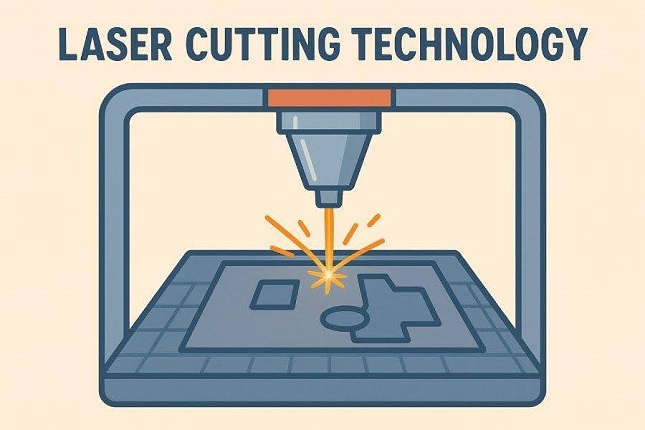Laser cutting technology represents a cornerstone in modern material processing and manufacturing industries, defined by its unparalleled precision and efficiency. It involves the use of a focused laser beam to cut, engrave, or mark materials, enabling complex shapes and fine details that traditional cutting methods often cannot achieve. This process, widely recognized for its precision cutting and versatility, covers a broad spectrum including laser engraving, laser marking, laser etching, and 3D laser cutting.
At its core, laser cutting harnesses industrial lasers—such as fiber lasers and CO2 lasers—to deliver a high-energy beam for material processing. The laser beam’s interaction with the workpiece, typically controlled by advanced CNC cutting machines integrated with CAD/CAM software, allows precise control over cutting speed, laser power, and laser focal length.
Fundamental Principles of Laser Cutting
Understanding laser cutting requires a grasp of its fundamental physical principles. Laser cutting primarily operates on the principle of thermal cutting, where a concentrated laser beam heats the material beyond its melting or vaporization point. The laser beam, characterized by key parameters such as laser spot size and laser beam quality, is tightly focused using specialized laser optics and a laser nozzle to achieve exceptional laser precision.
The cutting process involves creating a laser focal point that delivers energy into a small, localized area, melting or vaporizing the material. Assist gases are often employed to blow away molten material, enhancing cutting speed and quality. The entire system relies on precise coordination via numerical control and CAD/CAM software to modulate laser power supply, pulse laser characteristics, or continuous wave laser outputs depending on material properties and desired outcomes. Visit ACRA Machinery for more details.
Types of Lasers Used in Laser Cutting
Several types of lasers facilitate diverse laser cutting applications:
- CO2 Lasers: These gas lasers, initially the backbone of laser cutting technology, operate at wavelengths ideal for cutting non-metals such as plastics, wood, and textiles, as well as certain metals.
- Fiber Lasers: Due to their efficiency and high beam quality, fiber lasers have dominated the metal cutting and sheet metal fabrication industries. Fiber lasers use optical fibers as the medium to carry the laser beam, offering compact, energy-efficient solutions that support high cutting speeds and excellent laser spot size control.
- Pulse and Nanosecond Lasers: Pulse lasers emit a series of high-energy laser pulses, critical for applications requiring low heat input and precise material removal, like micro-machining and laser etching. Nanosecond lasers, with ultra-short pulse durations, minimize thermal damage and improve surface finish, which is increasingly relevant in high-precision sectors.
Step-by-Step Laser Cutting Process
The laser cutting process harnesses the exceptional precision of a laser beam—often provided by either a fiber laser or CO2 laser source—to execute highly accurate cuts on diverse materials. Initially, the design is created using CAD/CAM software, which translates complex geometric models into numerical control (NC) code for the laser control systems. This data is then fed into the laser cutting machinery, enabling precise machine movements.
Once the machine receives instructions, the laser power supply activates the laser source, producing a highly focused laser beam. The laser head, equipped with a laser nozzle and advanced laser optics, directs this beam onto the workpiece. Modulation of the laser beam—whether using pulse lasers or continuous wave lasers—allows for control over laser processing parameters like cutting speed, laser spot size, and laser focal length for optimizing cutting performance.
During material processing, the intense thermal cutting effect generated by the laser beam vaporizes or melts the substrate, with assist gases sometimes employed to blow away molten material. Automation robotics integrated within industrial automation solutions often manage the loading, unloading, and positioning of sheet metal fabrication components, facilitating efficient 3D laser cutting or flat cutting operations.
Laser system integration with CNC cutting technologies maintains exact numerical control, ensuring laser precision throughout the process. After cutting, additional operations such as laser engraving, laser marking, or laser etching can be performed using the same laser system to add surface details or traceability codes.
Safety Measures and Precautions in Laser Cutting
Operators should employ comprehensive laser safety training, utilizing protective eyewear tailored to the specific wavelength emitted by fiber lasers or CO2 lasers. Effective laser maintenance routines, addressing cleanliness and alignment of laser optics and laser heads, also reduce hazards like unexpected beam reflections or scattering.
Ventilation systems are necessary to extract fumes and particulates generated during thermal cutting, especially when processing plastics or composites. Automation, robotics, and laser control systems help minimize human intervention, further enhancing workplace safety.










































